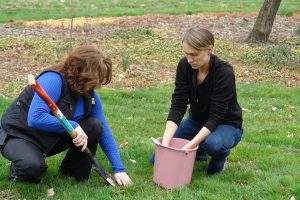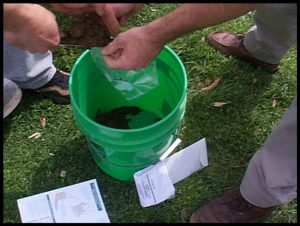It is hard to believe, but spring really is around the corner. Soon many landscape companies will whip into action providing lawn and landscape services for all those homeowners anxious to get their yards and gardens in shape for the coming season. It is hard for homeowners to assess whom to hire to manage their lawns and gardens. Recently, I heard from a landscaper who was frustrated upon hearing a competitor tell her customer there was no need to test the soil before applying fertilizer. That is just wrong. A soil test is always a first step in proper lawn and landscape management. Everything starts with good soil. Plants will not grow properly unless they get water, nutrients and support from the soil.
Testing the soil will tell you the pH; whether the soil is acidic (low pH), neutral, or alkaline (high pH). Lawns grow best at a soil pH or 6.0 – 6.5. Some plants, like blueberries, camellias, azaleas and rhododendrons like the soil to be somewhat acidic, about 5.5. Other plants, like boxwood, lilac, deutzia and weigelia like a neutral to slightly alkaline soil, about 7.0-7.5. The only way to know what pH you are starting with is to take a soil test. Once you know your soil’s pH, you can lower it by adding sulfur or raise it by adding lime. You can also keep the soil at its current pH and select the plants that will thrive in those conditions. But, if you plan to have a lawn, you wil need to make sure the soil pH is 6.0 to 6.5. At that pH, nutrients the lawn needs are available, they are not present in toxic quantities, and microorganisms necessary to maintain healthy soil structure will thrive.
Testing the soil will also tell you quantities of phosporus, potassium, calcium, magnesium and sulphur present in your soil. If you want to know about micronutrients, you can request a special test. But, micronutrients are always present in soil and only become a problem for plant growth if the pH is too low (manganese toxicity) or too high (iron unavailable to plants). Phosphorus is a nutrient we worry about in Delaware streams, rivers and bays. Phosphorus adheres to the soil, so erosion will carry soil, and with it phosphorus, to bodies of water. Plant debris, such as leaves, grass clippings, yard waste etc., contains phosphorus as well, so rains that carry those materials into the water will cause phosphorus pollution. It is against the nutrient management law in Delaware to add phosphorus to soils already high in phosphorus on sites greater than 10 acres. Sites smaller than 10 acres do not require a nutrient management plan, so it is not against the law, but it is certainly a bad idea, environmentally.
No one should be applying fertilizer without taking a soil test first. The University of Delaware has a soil testing service (http://extension.udel.edu/dstp/) or you can use a private soil testing lab. Get off to a good start this spring, and test your soil before adding fertilzer!
If you want to learn more about horticulture in Delaware, follow my instagram (sbartonhort).

The proper way to take a soil test is to take 10 samples from the area you want to test and mix them in a bucket. Then pull the sample from that mixed bucket of soil. Tracy Wootten and Carrie Murphy, Extension Agents in Sussex and New Castle counties, respectively, are demonstrating that process.

Once the samples are mixed in the bucket, fill the plastic bag that comes with your soil testing kit with soil.





thank you for sharing